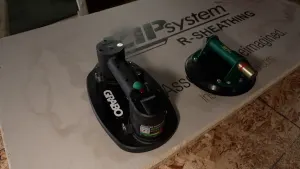Cat5e vs Cat6 Cable – Which Low Volt Cable should I use?
I’ve heard for years that wireless is the wave of the future, yet I never seem to have problems with my wired devices. I think for the short-term that you should still run some hard-wired ethernet cables to places you want the internet.
In this post I’m going to explore the differences between CAT5e and CAT6 Cable. Most of this information I gleaned from a client of mine who is an Electrical Engineer and ran all the low-volt cables for his house I’m building for him.
 |
| CAT 6 Ethernet Cable in one of my houses. It helps to have multiple colors for when you complete the terminations. |
 |
| I think that running the cable is relatively easy, but it’s the terminations that are a pain. Unless you have the patience to terminate all these wires, my recommendation is to pay someone to run your cable. |
 |
| You can buy 500′ and 1000′ boxes of cable for not much money. |
BASICS:
– avoid cat5. cat5e or better.
– cat5e can do gigabit Ethernet without any problem, supposedly up to 100m
– cat6 can do gigabit Ethernet up to 100m
10gbps Ethernet is coming, and cat6 can do that a bit better than cat5e (55 meters vs. 45 meters I read somewhere).
Bottom line: both have plenty of headroom for the foreseeable future for general data.
———-
Reasons to go Cat6:
– It’s cooler…
– cat6 cable is built to a slightly higher standard and may be able to reject interference slightly better (aka it can’t hurt)
– It’s only $110 (vs $85 for Cat5e) for 1000ft roll – I priced it at Monoprice.com
– some other uses of ethernet cable (HDMI baluns, etc.) will do better with better cable
– it can’t hurt
———-
Reasons not to go Cat6:
– $105 vs. $80
– slightly thicker/stiffer, tougher to pull
– To truly claim cat6, you’ll need patch panels and wall plates rated cat6. (cat5e ones will work, but lose much of the benefit of cat6 cable). Presumably these will be more expensive (no data yet)
– By the time cat5e runs out of steam, there will be some new standard (in home fiber, 100gbps wireless, etc.) and it won’t matter.
If you are planning to hire a company to do the install for you, I’d probably tell you a good install of cat5e was good enough, no problems for gig Ethernet, and you will save a bit of money.
However, it’s likely that the real money is in the labor and the delta for cat6 might not be that much. If you plan to run the wires yourself then I’d make the jump to Cat6.
In the end my client Paul choose to use Cat6 for the house I’m building for his family.
 |
| The bundled multi colored cable on the left is Cat 6. The Blue Conduit (called “Smurf Tubes” in our industry) give a great option for future expansion behind this kitchen cabinet wall. |
Best, Matt Risinger
Risinger Homes is a custom builder and whole house remodeling contractor that specializes in Architect driven and fine craftsmanship work. We utilize an in-house carpentry staff and the latest building science research to build dramatically more efficient, healthy, and durable homes.
Be sure to check out my video blog on YouTube, and follow me on Twitter @MattRisinger
Or follow my company Risinger Homes on Facebook.
You can also check out my new Amazon Store here with Matt Risinger approved items.

 Share on facebook
Share on facebook Tweet
Tweet Email
Email Share on Linkedin
Share on Linkedin

















